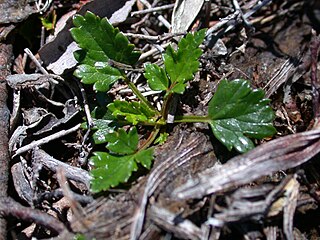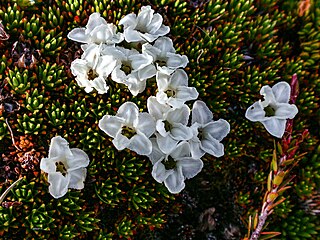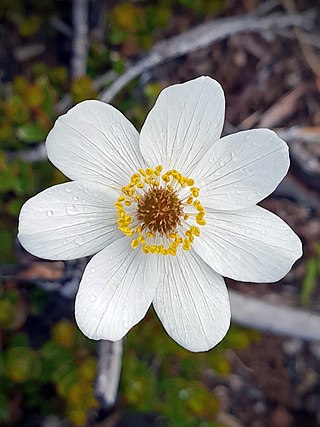
Diselma archeri is a species of plant of the family Cupressaceae and the sole species in the genus Diselma. It is endemic to the alpine regions of Tasmania's southwest and Central Highlands, on the western coast ranges and Lake St. Clair. It is a monotypic genus restricted to high altitude rainforest and moist alpine heathland. Its distribution mirrors very closely that of other endemic Tasmanian conifers Microcachrys tetragona and Pherosphaera hookeriana.

Athrotaxis cupressoides, commonly known as pencil pine, despite being a species of the family Cupressaceae and not a member of the pine family. Found either as an erect shrub or as a tree, this species is endemic to Tasmania, Australia. Trees can live for upwards of 1000 years, sustaining a very slow growth rate of approximately 12 mm in diameter per year.

A cushion plant is a compact, low-growing, mat-forming plant that is found in alpine, subalpine, arctic, or subarctic environments around the world. The term "cushion" is usually applied to woody plants that grow as spreading mats, are limited in height above the ground, have relatively large and deep tap roots, and have life histories adapted to slow growth in a nutrient-poor environment with delayed reproductivity and reproductive cycle adaptations. The plant form is an example of parallel or convergent evolution with species from many different plant families on different continents converging on the same evolutionary adaptations to endure the harsh environmental conditions.

Donatia novae-zelandiae is a species of mat-forming cushion plant, found only in New Zealand and Tasmania. Common names can include New Zealand Cushion or Snow Cushion, however Snow Cushion also refers to Iberis sempervirens. Donatia novae-zelandiae forms dense spirals of thick, leathery leaves, creating a hardy plant that typically exists in alpine and subalpine bioclimatic zones.

Gaultheria hispida, commonly known as the copperleaf snowberry, is an endemic eudicot of Tasmania, Australia. It is an erect multi-branched shrub, that can be found in wet forests and alpine woodlands. Its berries appear snowy white and leaves are tipped with a copper tinge, hence the common name.

Ewartia planchonii, commonly known as creeping cushionherb, is an endemic herb to alpine areas of Tasmania. E. planchonii is commonly found in the western highlands of Tasmania. The Ewartia genus is described as cushion plants/herbs due to the characteristic growth habits of low growing, highly compact mats which are made up of highly packed stems. These mats are slow-growing and are often located in soils that contain low nutrients.

Orites revolutus , also known as narrow-leaf orites, is a Tasmanian endemic plant species in the family Proteaceae. Scottish botanist Robert Brown formally described the species in Transactions of the Linnean Society of London in 1810 from a specimen collected at Lake St Clair. Abundant in alpine and subalpine heath, it is a small to medium shrub 0.5 to 1.5 m tall, with relatively small, blunt leaves with strongly revolute margins. The white flowers grow on terminal spikes during summer. Being proteaceaous, O. revolutus is likely to provide a substantial food source for nectivorous animal species within its range.

Gleichenia alpina, commonly known as alpine coral-fern, is a small fern species that occurs in Tasmania and New Zealand. It grows in alpine and subalpine areas with moist soils and is a part of the Gleichrniaceae family.

Tasmanian cushion plants are low growing, highly compact, woody, spreading mats that can grow up to 3 m in diameter, located mainly on the island of Tasmania. These mats are made up of tightly packed stems that grow at the same rate so that no apical rosettes protrude above the rest. The term cushion plant refers to a characteristic growth habit adopted by various species from a range of families to adapt to alpine and subalpine environments and areas of high latitude. They are adapted to grow in low nutrient areas and typically have deep taproots. Cushion plants are very slow growing and do not grow high above ground; mounds typically remain under 30 cm high. Underneath the living surface of the cushion, the plants either allow dead leaves to persist or produce non-photosynthetic material, resulting in an insulating effect.

Prionotes is a genus of flowering plants endemic to Tasmania, with a single species, Prionotes cerinthoides. Commonly known as climbing heath, it is a temperate rainforest climber or a small scrambling shrub in the mountains. It usually lives in very wet, undisturbed places.

Astelia alpina called pineapple grass, silver astelia, or perching lily is a commonly found species in alpine and subalpine areas of Tasmania and the Australian Alps. It is a perennial herb that typically dominates its environment by growing in dense clusters, called mats, in alpine bogs. There are two subspecies: Astelia alpina var. novae hollandiae from New South Wales and Victoria and Astelia alpina var. alpina endemic to Tasmania. Both subspecies appear very similar to each other. The species was originally described by Robert Brown.

Trochocarpa thymifolia is a species of flowering plant from the family Ericacae and is endemic to Tasmania. It is a widespread alpine and subalpine shrub with small leaves, pink to red flowers and blue to purple fruit. Originally described by botanist Robert Brown in 1810, it is a widespread Tasmanian endemic that inhabits the state's mountain regions.

Trochocarpa gunnii, commonly known as sweet-scented trochocarpa or fragrant purpleberry, is a common rainforest understorey shrub from the plant family Ericaceae endemic to Tasmania.

Rubus gunnianus is a species in the genus Rubus of the family Rosaceae. It is a small herb that grows in subalpine and alpine habitats above 900m throughout Tasmania, and bears edible fruit. It is commonly known as the native strawberry or Tasmanian alpine raspberry.

Abrotanella forsteroides, commonly known as the Tasmanian cushion plant, is an angiosperm endemic to Tasmania, Australia. The plant is a dicot species in the daisy family Asteraceae and can be identified by its bright green and compact cushion like appearance.
Abrotanella scapigera is an endemic angiosperm of Tasmania, Australia. It is a member of the daisy family (Asteraceae), commonly found in alpine regions of northwest and south-central Tasmania. This species is named after its characteristic sparsely leaved flowering stem that distinguishes it from the other 18 species of the Genus.

Olearia ledifolia, commonly known as rock daisy bush, is a species of flowering plant of the family Asteraceae. It is endemic to Tasmania and found at higher altitudes where it grows as a low, compact bush with tough, leathery leaves and small white and yellow daisy-like "flowers" in summer.

Dracophyllum minimum, commonly known as heath cushionplant or claspleaf heath, is a species of bolster cushion plant endemic to Tasmania, Australia. It is a low growing, highly compacted plant with white flowers, commonly found in alpine areas of the south, centre and west of Tasmania.

Ewartia meredithiae, commonly known as the rusty cushion plant, is a Tasmanian endemic cushion plant species. Out of the four species in Australia from this small genus, Tasmania has three, all of which are low growing, alpine species.

Anemone crassifolia, commonly known as mountain anemone, is a perennial herb in the family Ranunculaceae and is endemic to Tasmania, Australia. The species is common in high alpine moorlands of western and southern Tasmania at approximately 1000m. It is the only representative of the genus Anemone found in Australia.



















